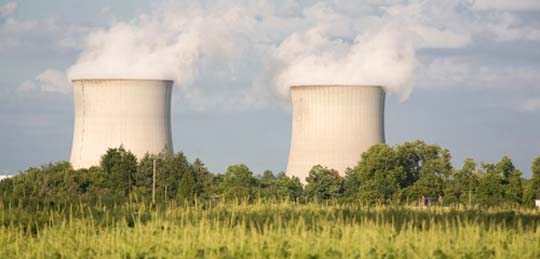



Nuclear energy is energy in the nucleus (core) of an atom. Atoms are tiny particles that make up every object in the universe. There is enormous energy in the bonds that hold atoms together. Nuclear energy can be used to make electricity. But first the energy must be released. In can be released from atoms in two ways: nuclear fusion and nuclear fission. In nuclear fusion, energy is released when atoms are combined or fused together to form a larger atom. This is how the sun produces its solar energy. Nuclear fusion (see video) produces no radioactivity and is 1 million times more effcient at creating energy than through nuclear fission. In nuclear fission, atoms are split apart to form smaller atoms, releasing energy. Nuclear power plants use nuclear fission to produce electricity.
The fuel most widely used by nuclear plants for nuclear fission is uranium. Uranium is nonrenewable, though it is a common metal found in rocks all over the world. Nuclear plants use a certain kind of uranium, U-235, as fuel because its atoms are easily split apart. Though uranium is quite common, about 100 times more common than silver, U-235 is relatively rare. Most U.S. uranium is mined in the Western United States. Once uranium is mined the U-235 must be extracted and processed before it can be used as a fuel.
Nuclear power accounts for about 19 percent of the total net electricity generated in the United States, about as much as the electricity used in California, Texas and New York. There are nuclear power plants throughout the United States.
Most power plants burn fuel to produce electricity, but not nuclear power plants. Nuclear plants use the heat given off during fission as fuel. Fission takes place inside the reactor of a nuclear power plant. At the center of the reactor is the core, which contains the uranium fuel.
The uranium fuel is formed into ceramic pellets. The pellets are about the size of your fingertip, but each one produces the same about of energy as 150 gallons of oil. These energy-rich pellets are stacked end-to-end in 12-foot metal fuel rods. A bundle of fuel rods is called a fuel assembly.
Fission generates heat in a reactor just as coal generates heat in a boiler. The heat is used to boil water into steam. The steam turns huge turbines blades, which drive generators to make electricity. Afterward, the steam is changed back into water and cooled in a separate structure at the power plant called a cooling tower. The water can be used again and again.
Compared to electricity generated by burning fossil fuels, nuclear energy is clean. Nuclear power plants produce no air pollution or carbon dioxide but a small amount of emissions result from processing the uranium that is used in nuclear reactors.
Like all industrial processes, nuclear power generation has by-product wastes: spent fuels, other radioactive waste, and heat. Spent fuels and other radioactive wastes are the principle environmental concern. Most nuclear waste is low-level radioactive waste. It consists of ordinary tools, protective clothing, wiping cloths and disposable items that have been contaminated with small amounts of radioactive dust and particles. These materials are subject to special regulations that govern their disposal so they will not come in contact with the outside environment.
Spent fuel assemblies are highly radioactive and must initially be stored in specially designed pools resembling large swimming pools or in specially designed dry storage containers. The United States Department of Energy’s long-range plan is for this spent fuel to be stored deep in the earth in a geologic repository, at Yucca Mountain, Nevada.
Nuclear energy has been the subject of intense debate since it's emergence as an energy source. The current controversy is whether to classify it as a source of renewable energy. The current class of renewable, or alternative energy sources - solar, wind, geothermal, biomass, hydroelectric and tidal do not want to compete with nuclear energy for government funds. They argue that "renewable" is a term that also means "clean". The negatives associated with nuclear waste or potential nuclear accidents should disqualify nuclear energy from this classification.
Source: US Department of Energy - Nuclear Energy
877-331-1235 | © Copyright DASolar.com.